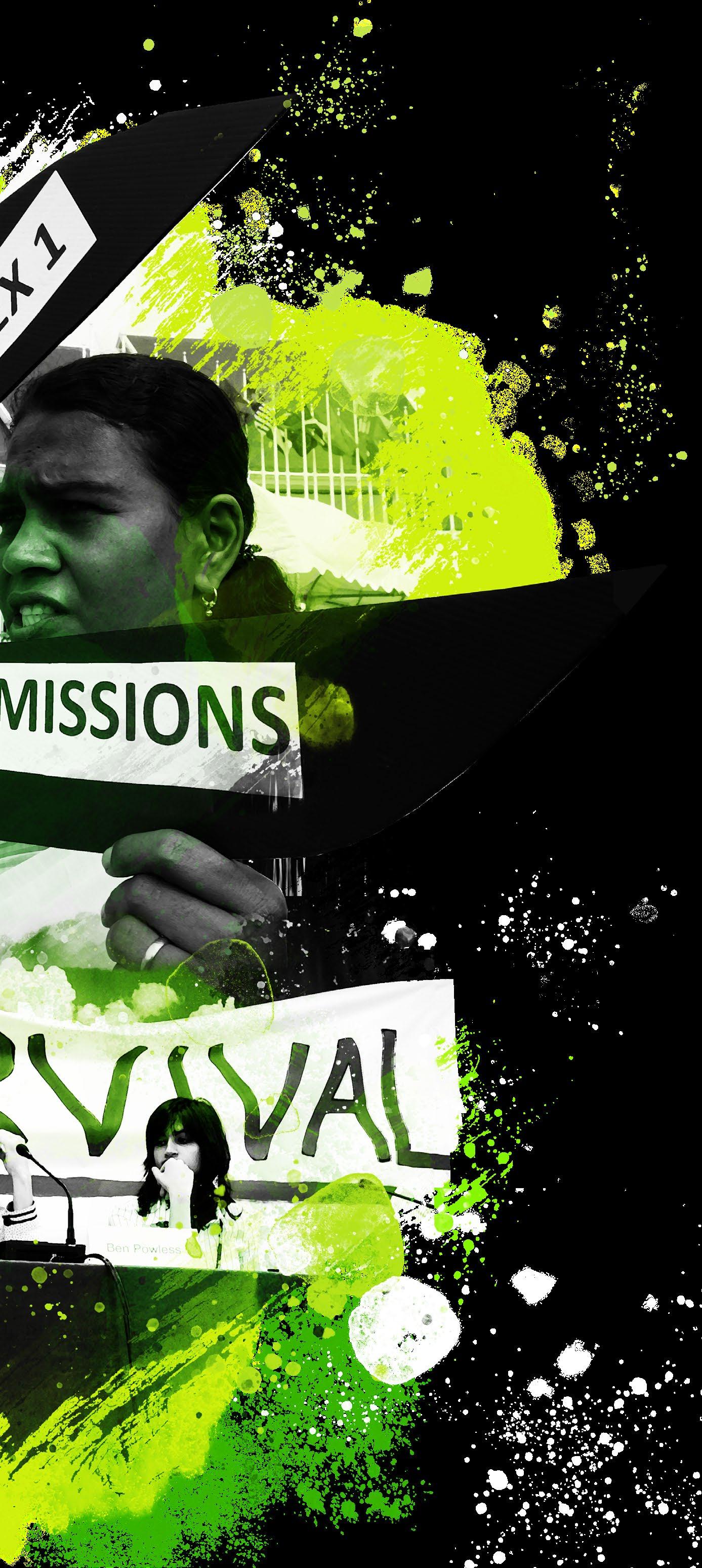
6 minute read
A history of the COP
The Intergovernmental Panel on Climate Change’s latest report into the science of climate change has generated much ado about it being yet another wake-up call for the Earth’s future. Coming just two months ahead of COP26 in Glasgow, there is some hope that governments will finally act to reverse the course of rising greenhouse gas emissions, including by phasing out fossil fuels, and address the grave impacts of climate change.
For those who have been following the UN process of successive COPs for some time, such expectations are viewed as wishful, mainly due to the recalcitrant conduct of developed countries. Their history at COPs is one of broken promises and shifting the goalposts from what has been agreed to, and reinterpreting agreements to suit their corporate vested agendas.
But before the developing world takes the bait, it is vital that we recall the broken promises and false solutions that detract from the real action needed now to limit temperature rise to below 1.5C from pre-industrial levels.
Broken promises and shifting goalposts
A history of the COP
Ever since the world agreed a fragile framework to tackle climate change in the 1990s, rich countries have been in denial about their responsibility for causing the problem, and what that means for how we deal with it, writes MEENA RAMAN.
ON THE BASIS OF EQUITY
Ever since it came into effect in 1994, the UN Framework Convention on Climate Change (UNFCCC) has acknowledged that developed countries have been responsible for “the largest share” of historical and current emissions, and that the share of global emissions from developing countries would need to “grow to meet their social and development needs”.
© Steve Kong


Top: A Jubilee South APMDD protest in Bangkok in 2011. Bottom: Activists at COP14 in Poznan in 2008.
As a result, the Convention’s fundamental principle was that governments would protect the climate “on the basis of equity and in accordance with their common but differentiated responsibilities and respective capabilities”. This meant that developed countries would “take the lead” in combating climate change and its effects and transfer finances and technology to developing countries to support mitigation and adaptation. The Kyoto Protocol was enacted in 1997 to agree specific legally binding commitments within this framework. However, the first commitment period from 2008 to 2012 only saw developed countries (known as Annex 1 countries) sign up to aggregate emissions cuts of 5% compared to 1990 levels. Despite this very low ambition, the United States left the Protocol.
Efforts soon began for a post-2012 agreement that would get the US back on board, resulting in a big north-south battle at COP13 in Bali in 2007. The global north’s spin was that Kyoto expires in 2012 and a new treaty to replace it was needed. Their agenda was to get the US to commit to emissions cuts alongside cuts by developing countries, and to remove the link to the provision of finance and technology.
The global south insisted that Kyoto was not dead, and what was needed was agreement on the second Kyoto commitment period. This meant a top-down aggregate target for developed countries of at least 2540% cuts from 1990 levels by 2020. Yet the final Bali outcomes made no such commitment, following opposition mainly from the US.
Instead, in return for agreement on the second Kyoto period at Bali, a comprehensive process was launched to enable the full implementation of the Convention up to and beyond 2012. This was actually the precursor to the eventual Paris Agreement that was adopted in 2015.
FROM TARGETS TO PLEDGES
After Bali, a new ‘pledge and review’ system was introduced at COP16 in Cancun in 2010. This became the precursor to the nationally determined contributions (NDCs) of the Paris Agreement, where all governments can pledge what reductions they can undertake, without a reference to an international target or approach.
Countries like India, Bolivia, Ethiopia and others advanced the idea of ‘equitable access to atmospheric space’ in the negotiations. This proposed a fairer allocation of the remaining global carbon budget under a temperature limit, taking into account countries’ historical and cumulative emissions, including on a per capita basis. But again, these equity-based proposals never saw the light of day, given the resistance of developed countries led especially by the US.
In the bottom-up ‘pledge and review’ world of the NDCs, there is bound to be an ‘emissions gap’ between what countries should do to limit temperature rise and what they nationally determine. Developed countries now call on all countries to plug the emissions gap, which turns the founding principle on its head to ‘common and shared responsibilities’, with no reference to historical responsibility or equity between the north and south.
NET ZERO SHIFTS THE GOALPOSTS
The latest ploy is in advancing a ‘net zero’ target for all countries by mid-century, on the basis of the Paris Agreement. Article 4.1 refers to achieving a balance between cutting emissions from sources and removals by carbon sinks by 2050, yet it is a global aspiration. It does not advance net zero as an approach for individual countries, because developed countries need to move faster than this.
The IPCC Special Report on 1.5C warming in 2018 estimated that the remaining global carbon budget to give a 50% chance of restricting temperature rise to less than 1.5C is 480 gigatonnes of carbon dioxide equivalent. At present rates, this entire budget will be consumed by about 2030. Even if emissions start to fall now at a regular rate, global net zero is needed by 2039. If it’s not reached until 2050, it will mean a greater than 70% chance of exceeding 1.5C of warming.
Far from signifying climate ambition, net zero is being used by a majority of polluting governments and corporations to greenwash businessas-usual. At the core of these pledges are small and distant targets that require no action for decades, and promises of technologies that are unlikely ever to work at scale, and which are likely to cause huge harm if they come to pass.
In fact, according to the UNFCCC Secretariat, developed countries on aggregate had achieved only 13% emissions reductions on 1990 levels by 2018. Countries in Western Europe plus the United States, Japan, Australia, New Zealand and Canada have not managed to reduce their aggregate emissions between 1990 and 2020 at all.
Worse, COP26 is where the rules for implementing carbon markets will be agreed, which is yet another route to escape from real emissions reductions at home for developed countries.
Below: COP17 in Durban in 2011 culminated in a mass protest inside the conference centre against rich country demands.
WHAT TO EXPECT AT COP26

Developed countries’ failure to cut emissions has been matched by a failure to provide the promised climate finance for mitigation and adaptation.
In order to secure a deal in Copenhagen in 2009 and then in Cancun in 2010, developed countries agreed to mobilise $100 billion per year by 2020. Yet they have failed to meet this promise and in 2015 in Paris, the goalposts to meet this target were extended to 2025 (see page 18-19).
Beyond the broken promises, there is also a reluctance to engage in any discussion on finance for addressing loss and damage. This is a major problem, because what climate science is showing is that the adverse impacts of climate change are getting worse and worse, with much damage to developing countries where it is no longer possible to just adapt.
Given the track-record of developed countries, there is real danger that COP26 will see more tricks being played to give the illusion that the world is on track to limit temperature rise to below 1.5C. It can be expected that more promises will be made by rich countries that there will be increased money coming if more developing countries get on board with longterm net zero targets, and agree to the rules for carbon markets. Then, Glasgow would be declared a so-called ‘successful’ COP, but not all of us will be applauding.
Meena Raman is senior researcher at the Third World Network, www.twn.my.











